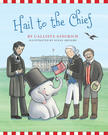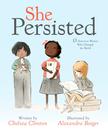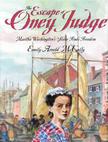Want to teach your children U.S. history? Here’s where to start.
Anyone who spends time with a 4- or 5-year-old should be prepared to answer a lot of questions. Who is that? What are those? Why do we do it that way? How do these work? Curiosity, we know, is a driving force for young children—curiosity about themselves and the world around them, the waters and the dry land, the moon and the stars, the fish in the sea and the birds in the air and every creeping thing that creeps upon the earth.
Most of all, they are curious about people. Studies have shown that the brains of babies as young as 4 months old can already process faces at nearly adult levels (while objects light up only a lower-level area of the visual system). It follows that the most compelling picture books for beginning readers and learners—the 4- to 8-year-old crowd—will be deeply human-centered. Oh, and they must tell a cracking good story, with strong, appealing visuals. Such books have the capacity to expand horizons, cultivate empathy and engage the imaginations of our citizens-in-formation.
With these criteria in mind, let us venture onto the troubled waters of American history. As the ongoing controversies over Confederate monuments demonstrate, there is clearly more work for Americans to do to understand the meaning of our country’s unfinished journey toward life, liberty and the pursuit of happiness. “All men are created equal,” as we know, left out whole swaths of the American population, and that omission still reverberates along the highways and byways of these United States. Perhaps it is not surprising that at this particular moment in our national discourse, as I consulted children’s librarians and browsed library shelves in search of history books for small people, I found myself gravitating to books that put a human face on the complexities of America’s past—a human face that seems, this summer, to have eluded the grown-ups.
A survey of children's books that put a human face on the complexities of America’s past
American history picture books come in two flavors: nonfiction and historical fiction. The nonfiction list encompasses biography, of course, as well as thematic books and straight-down-the-line accounts of events and dates in our country’s history. This may seem like a tall order for a young child—what can the Boston Tea Party or taxation without representation really mean to a 5-year-old? But to those who go so far as to maintain that it is developmentally inappropriate to teach history to young children, the best rejoinder is that of the founder of an independent elementary school in New Hampshire, who observed, “Piaget told us that young children are ‘concrete thinkers.’ He did not tell us that they are blockheads.” Nonetheless, there is considerable variation in the accessibility and appeal of nonfiction books.
To begin with the concrete, the Dorling-Kindersley Eyewitness Books are a child-friendly emporium of archival material: page after page displays images of artefacts, documents and people from a particular event, era or human enterprise, accompanied by brief explanatory narratives and captions. These are intelligently laid out and full of detail. Among the ones that still claim a place on my bookshelf are those on the American Revolution, the Civil War and World War II. (The series is not exclusively military; the range of U.S. subjects alone includes baseball, first ladies and Texas.) The last 4year-old to bestride my household—now a six-foot-tall high-school linebacker—counted these among his favorites; he would pore over the illustrations for hours, lingering over photographs of Civil War field artillery or the D-Day invasion. These books are a wonderful resource for any home library.
These books often seem to have a thinly veiled political provenance, as the authors’ names suggest: Lynne Cheney, Callista Gingrich, Chelsea Clinton.
On the more abstract end of the spectrum are works that depict the values and ideals behind the “American experiment.” These books often seem to have a thinly veiled political or even partisan provenance, as the authors’ names suggest: Lynne Cheney, Cokie Roberts, Callista Gingrich, Chelsea Clinton. Mrs. Cheney’s book, America: A Patriotic Primer (Simon & Schuster, 40 pp., $19.99), is actually more balanced than one might initially expect. It transports the reader in orderly fashion through the alphabet of American history (“S is for Suffrage,” with drawings of Lucretia Mott, Elizabeth Cady Stanton and Sojourner Truth, among others). The rubric for each letter is embellished by brief commentary and, frequently, quotations. The page for Martin Luther King Jr. (“K is for King”) is adorned with his famous “I have a dream” statement. Extensive endnotes give more information about each subject in the book. The illustrations are charming, the text reads well, and I did not feel that Mrs. Cheney was preaching.
Callista Gingrich, whose husband, Newt, is a former speaker of the House, entered this field of (American) dreams in 2011 with Sweet Land of Liberty (Regnery Kids, 28 pp., $14.95), the first in a series featuring Ellis the Elephant. Allow me to introduce our hero in the words of his creator:
Ellis the Elephant was a smart little guy,
with a curly grey trunk and a twinkling eye.
He liked asking questions, he was eager to see
how America became the land of the free!
A veritable Forrest Gump, Ellis pops up at Plymouth Rock, the Boston Tea Party, Iwo Jima, the moon…. Although Ellis does have a nice twinkle to his eye, he never really achieves the status of a bona fide character; he feels more like a prop to the message, or a structuring element.
Mrs. Gingrich has published a new installment in the series annually. The most recent volume, out just in time for the 2016 presidential election, is Hail to the Chief (Regnery Kids, 40 pp., $16.99). As Ellis makes his way through the Callista-curated gallery of American presidents, one feels increasingly in the grip of a docent who will make her opinions known. The very issue of who’s in and who’s not is telling. While I can understand omitting Millard Fillmore and Calvin Coolidge, does it not seem slightly suspect that the last president Ellis visits is Ronald Reagan?
Does it not seem slightly suspect that the last president Ellis visits is Ronald Reagan?
In addition to these political undercurrents, the books are dragged down by illustrations that, while colorful, lack depth or interest (not unlike Ellis himself). More unfortunate still is the author’s decision to write her books in rhymed verse. While some of the most delightful children’s books ever written are composed in verse, these are not among them. Here, form and content make awkward bedfellows, as clunky or forced rhymes are asked to carry sophisticated or abstract ideas:
President Harry Truman proposed an alliance
to unite the free nations in strong defiance.
The NATO agreement left many impressed
with the strength and resolve of the unified West.
Even a highly intelligent 4- or 5-year-old would be hard put to understand terms like alliance or free nations, let alone NATO. Caveat lector.
Several authors herald the unheralded women of American history. I was prepared to embrace Ladies of Liberty: The Women Who Shaped Our Nation (HarperCollins, 40 pp., $17.99) simply because it is illustrated by Diane Goode, whose book Where’s Our Mama? was a family favorite. Roberts and Goode collaborated on a previous book, Founding Mothers, that focused on the women who contributed to the birth of our nation—Abigail Adams, Eliza Lucas Pinckney, Martha Washington. This 2017 volume features women “who laid the groundwork for a better society,” among them Sacagawea, the African-American poet Lucy Terry Prince and Judith Sargent Murray, who in the late 18th century wrote articles advocating women’s rights. Goode’s charming illustrations do not disappoint, and Ms. Roberts capably illuminates lesser-known women who contributed a great deal to making America a better place. But I can’t imagine this book holding the attention of a 6-year-old girl. There is too much text, written at too high a level, for young children. Save this for the middle-schoolers in your life.
In this same category, Chelsea Clinton has penned She Persisted: 13 American Women Who Changed the World (Philomel Books, 32 pp., $17.99). Although not quite as blatant in its agenda as, say, the board book Feminist Baby, the blurb for the book clarifies the mission: it “introduces tiny feminists, mini-activists and little kids who are ready to take on the world to thirteen inspirational women who never took no for an answer.” Harriet Tubman, Helen Keller, Maria Tallchief, Florence Griffith Joyner and more, appealingly depicted in Alexandra Boiger’s drawings, fill these pages. And no, there is no entry for You-Know-Who, although she does appear in a painting in a red pantsuit. Must you ask?
And no, there is no entry for You-Know-Who, although she does appear in a painting in a red pantsuit. Must you ask?
Reading all of these tomes, from Cheney to Chelsea, left me feeling more instructed than entertained. By the time I had said adieu to Ellis, I was longing for a good story that would grab my imagination by the lapels and not let go. Luckily, there are many talented and passionate authors who migrate toward the genre of historical fiction, some of them towering figures in children’s literature.
The Escape of Oney Judge (Farrar, Straus and Giroux, 32 pp., $17.97), written and illustrated by the unsurpassed Emily Arnold McCully, tells the story of Martha Washington’s young slave girl, Oney. Brought from Mount Vernon to New York City (and then Philadelphia, to which the capital moved) as Mrs. Washington’s personal maid when General Washington is elected president, Oney encounters free blacks for the first time and senses the life that lies beyond her bondage in and to the Washington household. Forbidden to learn to read or earn money despite her skill as a seamstress, she finally sees an opportunity to run for freedom, and she takes it. The dramatic twists and turns of this beautifully illustrated story bring to life Oney and all those who help or hinder her on her journey. An Author’s Note provides the historical background. The Escape of Oney Judge is a deeply moving portrayal of the human orientation toward freedom.
Then there is Dave, another enslaved person whose legacy was his clay pots and the poems he scratched on them. The story of this 19th-century craftsman is told by Laban Carrick Hill in Dave the Potter: Artist, Poet, Slave(Little Brown Books for Young Readers, 40 pp., $18.99). This is a generous book, with lyrical language and gorgeous, powerful illustrations by Bryan Collier. It is simply beautiful to look at and a treat to read aloud.
More than 20 years ago, Deborah Hopkinson, another children’s literature “hall-of-famer,” collaborated with the illustrator James Ransome to create a picture book about a little-known episode in American history. Sweet Clara and the Freedom Quilt (Alfred A. Knopf, 40 pp., $7.99) tells of Clara, a young girl who is separated from her mother as a child and becomes a seamstress on a 19th-century plantation. What begins as the idle piecing together of cloth scraps becomes an ingeniously constructed map that enables Clara and other enslaved persons to find the path to freedom. The story of how Clara gathers the information she needs to complete her “freedom quilt” and makes her way north is inspiring. This book has become a much-loved classic for a reason.
Ms. Hopkinson returns to the subject of racial injustice in a more recent book, Sweet Land of Liberty (Peachtree Publishers, 32 pp., $16.95). Here she goes behind the scenes of Marian Anderson’s landmark performance at the Lincoln Memorial on Easter Sunday 1939, when the African-American opera singer sang to a crowd of more than 75,000 people. She focuses her story on Oscar Chapman, an assistant secretary of the interior, who quietly worked to bring about this concert in the face of race-based opposition. In recounting Mr. Chapman’s role in the drama, Hopkinson shows that all of us can play a role in dismantling the barriers of color and race in this country. Leonard Jenkins’s collage-like paintings create a dark, almost eerie atmosphere for this stirring tale.
“Tell me a story,” a young child begs. And so I end with a grandmother’s tale about the weaving of sweetgrass baskets, an art brought to coastal South Carolina hundreds of years ago by enslaved Africans. In rhythmic, enchanting prose, the author Margot Theis Raven draws the reader into an Africa of long ago and far away:
On the hills by the river grew pale stalks of rice
to feed the village and the spirits of the land.
By the banks of the river grew tall, grassy reeds
to weave into baskets to winnow the rice.
She spirits us then to the grasses of the South Carolina coast, where many of the enslaved who worked in the rice fields found the comfort of ritual and a remembered craft that connected them to their homeland.
But long night, after long day,
he sewed baskets in the old way,
from the bulrush that swooshed and hushed
by the marshes and the rivers that flowed to the sea.
In this beautiful—if slightly idealized—story about the preservation of a unique and intricate craft, the sweetgrass baskets constitute an unbreakable circle, perduring as the weavers move through the centuries from enslavement to freedom, forming “the knot that ties us all together.” Like the baskets themselves—which now command premium prices—this story spirals through time as a testament to the power of memory and tradition.
As the redoubtable heroine of Penelope Lively’s novel Moon Tiger (Penelope Press, 208 pp., $16) observes, “The voice of history, of course, is composite. Many voices; all the voices that have managed to get themselves heard.” Many of the books reviewed here are bringing to the fore voices that have not managed to get themselves heard in the past. These add deep and important tones to our composite self-understanding, imbuing it with color and richness in stories that will appeal both to young children and to those adults fortunate enough to read to them.
This article also appeared in print, under the headline “History for young readers, with bright colors and human faces,” in the Fall Literary Review 2017, issue.













